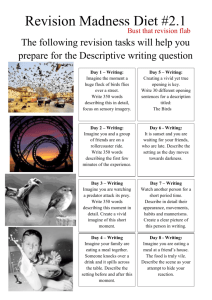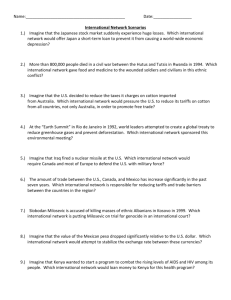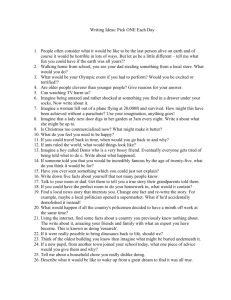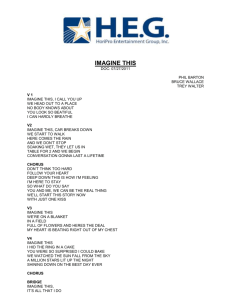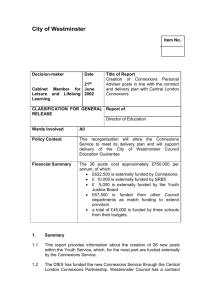9:10Richard Baraniuk: This costs 22 dollars to the student. Why
advertisement
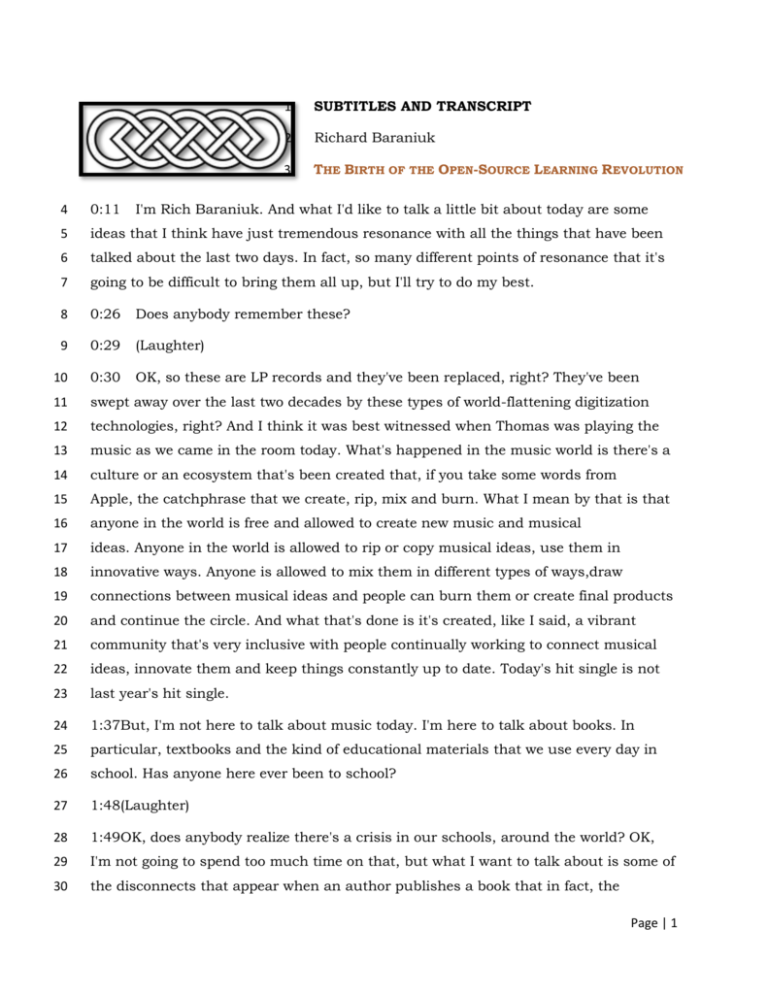
1 SUBTITLES AND TRANSCRIPT 2 Richard Baraniuk 3 THE BIRTH OF THE OPEN-SOURCE LEARNING REVOLUTION 4 0:11 I'm Rich Baraniuk. And what I'd like to talk a little bit about today are some 5 ideas that I think have just tremendous resonance with all the things that have been 6 talked about the last two days. In fact, so many different points of resonance that it's 7 going to be difficult to bring them all up, but I'll try to do my best. 8 0:26 Does anybody remember these? 9 0:29 (Laughter) 10 0:30 OK, so these are LP records and they've been replaced, right? They've been 11 swept away over the last two decades by these types of world-flattening digitization 12 technologies, right? And I think it was best witnessed when Thomas was playing the 13 music as we came in the room today. What's happened in the music world is there's a 14 culture or an ecosystem that's been created that, if you take some words from 15 Apple, the catchphrase that we create, rip, mix and burn. What I mean by that is that 16 anyone in the world is free and allowed to create new music and musical 17 ideas. Anyone in the world is allowed to rip or copy musical ideas, use them in 18 innovative ways. Anyone is allowed to mix them in different types of ways,draw 19 connections between musical ideas and people can burn them or create final products 20 and continue the circle. And what that's done is it's created, like I said, a vibrant 21 community that's very inclusive with people continually working to connect musical 22 ideas, innovate them and keep things constantly up to date. Today's hit single is not 23 last year's hit single. 24 1:37But, I'm not here to talk about music today. I'm here to talk about books. In 25 particular, textbooks and the kind of educational materials that we use every day in 26 school. Has anyone here ever been to school? 27 1:48(Laughter) 28 1:49OK, does anybody realize there's a crisis in our schools, around the world? OK, 29 I'm not going to spend too much time on that, but what I want to talk about is some of 30 the disconnects that appear when an author publishes a book that in fact, the Page | 1 31 publishing process -- just because of the fact that it's complicated, it's heavy, books 32 are expensive -- creates a sort of a wall between authors of books and the ultimate 33 users of books, be they teachers, students or just general readers. And this is even 34 more true if you happen to speak a language other than one of the world's major 35 languages, and especially English.And I'm going to call these people below the barrier 36 Shut-outs, because they're really shut out of the process of being able to share their 37 knowledge with the world. And so what I want to talk about today is trying to take 38 these ideas that we've seen in the musical culture and try to bring these towards 39 reinventing the way we think about writing books, using them and teaching from 40 them. So, that's what I'd like to talk about and really, how do we get from where we 41 are now to where we need to go? 42 2:50So, the first thing I'd like you to do is a little thought experiment. So, imagine 43 taking all the world's books.OK, everybody imagine books and imagine just tearing out 44 the pages. So, liberating these pages and imagine digitizing them and then storing 45 them in a vast, interconnected, global repository. Think of it as a massive iTunes for 46 book type content. And then take that material and imagine making it all open, so that 47 people can modify it, play with it, improve it. Imagine making it free, so that anyone in 48 the world can have access to all of this knowledge, and imagine using information 49 technology so that you can update this content, improve it, play with it, on a timescale 50 that's more on the order of seconds instead of years.Instead of editions coming out 51 every two years, of a book, imagine it coming out every 25 seconds. 52 3:39So, imagine we could do that and imagine we could put people into this. So that 53 we could truly build an ecosystem with not just authors, but all the people who could 54 be or want to be authors in all the different languages of the world, and I think if you 55 could do this, it would be called, well, I'm just going to refer to it as a knowledge 56 ecosystem. So, really, this is the dream and in a sense what you can think of it is we 57 are trying to enable anyone in the world, I mean anyone in the world, to be their own 58 educational DJ, creating educational materials, sharing them with the 59 world, constantly innovating on them. So, this is the dream. 60 4:15In fact, this dream is actually being realized. Over the last six-and-a-half 61 years, we've been working really hard at Rice University on a project called 62 Connexions, and so what I'd like to do for the rest of the talk is just tell you a little bit Page | 2 63 about what people are doing with Connexions, which you can kind of think of as the 64 counterpoint to Nicholas Negroponte's talk yesterday, where they're working on the 65 hardware of bringing education to the world. We're working on the open-source tools 66 and the content. So, that's sort of to put it in perspective here. 67 4:44So, create. So what are some of the people that are using these kind of 68 tools? Well, the first thing isthere's a community of engineering professors, from 69 Cambridge to Kyoto, who are developing engineering content in electrical 70 engineering to develop what you can think of as a massive, super textbook that covers 71 the entire area of electrical engineering -- and not only that, it can be customized for 72 use in each of their own individual institutions. If people like Kitty Jones -- right, a 73 shut-out -- a private music teacher and mom from Champagne, Illinois, who wanted to 74 share her fantastic music content with the world, on how to teach kids how to play 75 music. Her material is now used over 600,000 times per month. Tremendous, 76 tremendous use. In fact, a lot of this use coming from Unites States, K-through-12 77 schools because anyone who's involved in a school scale back, the first thing that's cut 78 is the music curriculum and so this is just indicating the tremendous thirst for this 79 kind of open, free content. A lot of teachers are using this stuff. OK, what about 80 ripping? 81 5:53What about copying, reusing, right? A team of volunteers at the University of 82 Texas El Paso, graduate students translating this engineering super textbook 83 ideas and within about a week, having this be some of our most popular material in 84 widespread use all over Latin America and in particular in Mexico,because of the open 85 extensible nature of this. People, volunteers and even companies that are translating 86 material into Asian languages like Chinese, Japanese and Thai, to spread the 87 knowledge even further. 88 6:26OK, what about people who are mixing? What does "mixing" mean? "Mixing" 89 means building customized courses, means building customized books. Companies 90 like National Instruments, who are embedding very powerful, interactive simulations 91 into the materials, so that we can go way beyond our regular kind of textbook to an 92 experience that all the teaching materials are things you can actually interact with 93 and play around with and actually learn as you do. Page | 3 94 6:55We've been working with Teachers Without Borders who are very interested in 95 mixing our materials.They're going to be using Connexions as their platform to develop 96 and deliver teaching materials for teaching teachers how to teach in 84 countries that 97 are around the world. TWB is currently in Iraq training 20,000 teachers supported by 98 USAID and to them, this idea of being able to remix and customize to the local context 99 is extraordinarily important, because just providing free content to people has actually 100 been likened by people in the developing world to a kind of cultural imperialism, that if 101 you don't empower people with the ability to re-contextualize the material, translate it 102 into their own language and take ownership of it, it's not good. OK, other 103 organizations we've been working with, UC Merced, people know about UC Merced. It's 104 a new university in California, in the Central Valley, working very closely with 105 community colleges. They're actually developing a lot of their science and engineering 106 curriculum to spread widely around the world in our system and they're also trying to 107 develop all of their software tools completely open-source. We've been working with 108 AMD, which has a project called 50 by '15, which is trying to bring Internet 109 connectivity to 50 percent of the world's population by 2015. We're going to be 110 providing content to them in a whole range of different languages. And we've also been 111 working with a number of other organizations. In particular, a bunch of the 112 projects that are funded by Hewlett Foundation, who have taken a real leadership role 113 in this area of open content. 114 8:35OK, burn, I think this is sort of, quite interesting. "Burn" is the idea of trying to 115 create the physical instantiation of one of these courses. And I think a lot of you 116 received, I think all of you received one of these music books in your gift pack. A little 117 present for you. Just to tell you quickly about it: this is an engineering textbook. It's 118 about 300 pages long, hardbound. This costs, anybody guess? How much would it 119 cost in a bookstore? 120 9:08Audience: 65 dollars. 121 9:10Richard Baraniuk: This costs 22 dollars to the student. Why does it cost 22 122 dollars? Because it's published on demand and it's developed from this repository of 123 open materials. If this book were to be published by a regular publisher, it would cost 124 at least 122 dollars. Page | 4 125 9:27So what we're seeing is moving this burning or publication process from the 126 regular sort of single-authored book towards community-authored materials that are 127 modular, that are customized to each individual class and published on demand very 128 inexpensively, either pushed out through Amazon, or published directly through an 129 on-demand press, like Coop. And I think that this is an extraordinarily interesting 130 area because there is tremendous area under this long tail in publishing. We're not 131 talking about the Harry Potter end, right at the left side. We're talking about books on 132 hyper geometric partial differential equations. Right, books that might sell 100 copies 133 a year, 1,000 copies a year. There is tremendous sustaining revenue under this long 134 tail to sustain open projects like ours, but also to sustain this new emergence of on- 135 demand publishers, like Coop, who produced these two books. And I think one of the 136 things that you should take away from this talk, is that there's an impending cut-out- 137 the-middle-man, disintermediation, that's going to be happening in the publishing 138 industry, and it's going to reach a crescendo over the next few years, and I think that 139 it's for our benefit, really, and for the world's benefit. 140 10:42OK, so what are the enablers? What's really making all of this happen? There's 141 tons of technology, and the only piece of technology that I really want to talk about is 142 XML. How many people know about XML?Oh, great, so it's the future of the web, 143 right? It's semantic representation of comment, content, and what you can really think 144 of XML in this case, is it's the packaging that we're putting around these 145 pages.Remember we took the book, tore the pages out? Well, what the XML is going to 146 do is it's going to turn those pages into Lego blocks. XML are the nubs on the 147 Lego that allow us to combine the content together in myriad different ways, and it 148 provides us a framework to share content. So, it lets you take this ecosystem in its 149 primordial state, right, of all this content, all the pages you've torn out of books, and 150 create highly sophisticated learning machines: books, courses, course packs. 151 11:39It gives you the ability to personalize the learning experience to each individual 152 student, so that every student can have a book or a course that's customized to their 153 learning style, their context, their language and the things that excite them. It lets you 154 reuse the same materials in multiple different waysand surprising new ways. It lets 155 you interconnect ideas indicating how fields relate to each other, and I'll just give you 156 my personal story. We came up with this six-and-a-half years ago because I teach the 157 stuff in the red box. Page | 5 158 12:12And my day job, as Chris said, I'm an electrical engineering professor. I teach 159 signal processing and my challenge was to show that this math -- wow, about half of 160 you have already fallen asleep just looking at the equation -- 161 12:24(Laughter) 162 12:25but this seemingly dry math is actually the center of this tremendously powerful 163 web that links technology -- that links really cool applications like music 164 synthesizers to tremendous economic opportunities, but also governed by intellectual 165 property. And the thing that I realized is there was no way that I, as an engineer, could 166 write this book that would get all of this across. We needed a community to do it and 167 we needed new tools to be able to interconnect these ideas, and I think that really, in a 168 sense, what we're trying to do is make Minsky's dream come to a reality, where you 169 can imagine all the books in a libraryactually starting to talk to each other. And people 170 who are teachers out here, whoever taught, you know this -- it's the interconnections 171 between ideas that teaching is really all about. 172 13:11OK, back to math. Imagine this is possible -- that every single equation that you 173 click on in one of your new e-texts is something that you're going to be able to explore 174 and experiment with. So imagine your kid's algebra textbook in seventh grade. You 175 can click on every single equation and bring up a little tool to be able to experiment 176 with it, tinker with it, understand it, because we really don't understand until we 177 do. The same type of mark-up, like mathML, for chemistry. Imagine chemistry 178 textbooks that actually understand the structure of how molecules are 179 formed. Imagine music XML that actually lets you delve into the semantic structure of 180 music, play with it, understand it. It's no wonder that everybody's getting into it, 181 right? Even the three wise men. 182 13:59(Laughter) 183 14:00OK, the second big enabler, and this is where I told a big lie. The second big 184 enabler is intellectual property, because in fact I got up here and I talked about how 185 great the music culture is. We can share and rip, mix and burn, but in fact that's all 186 illegal. And we would be accused of pirates for doing that,because this music has been 187 propertized. It's now owned, right, much of it by big industries. So, really, the key 188 thing here is we can't let this happen. We can't let this Napster thing happen here. So, 189 what we have to do is get it right from the very beginning and what we have to do is Page | 6 190 find an intellectual property framework that makes sharing safe, and makes it easily 191 understandable, and the inspiration here is taken from open-source software, things 192 like Linux and the GPL. 193 14:52And the ideas, the creative commons licenses. How many people have heard of 194 creative commons? If you have not, you must learn about it. Creativecommons.org. At 195 the bottom of every piece of material in Connexions and in lots of other projects, you 196 can find their logo. Clicking on that logo takes you to an absolute no- 197 nonsense, human-readable document, a deed, that tells you exactly what you can do 198 with this content. In fact, you're free to share it, to do all of these things, to copy it, to 199 change it, even to make commercial use of it as long as you attribute the 200 author. Because in academic publishing and much of educational publishing, it's 201 really this idea of sharing knowledge and making impact that's why people write, not 202 necessarily making bucks. We're not talking about Harry Potter, right? We're at the 203 long tail end here. Behind that is the legal code, so if you want to very carefully 204 construct it, and creative commons is taking off -- over 43 million things out 205 there, licensed with a creative commons license. Not just text, but music, images, 206 video, and there's actually a tremendous uptake of the number of people that are 207 actually licensing music to make it free for people who do this whole idea of re- 208 sampling, rip, mixing, burning and sharing. 209 16:13So I'd like to conclude with just the last few points. So, we've built this idea of a 210 commons. People are using it. We get over 500,000 unique visitors per month, just to 211 our particular site. MIT open courseware, which is another large open-content 212 site, gets a similar number of hits, but how do we protect this? How do we protect it 213 into the future? And the first thing that people are probably thinking is quality control, 214 right? Because we're saying that anybody can contribute things to this commons. 215 Anybody can contribute anything. So that could be a problem. 216 16:51It didn't take long until people started contributing materials, for example, on 217 lingerie, which is actually a pretty good module. The only problem is it's 218 plagiarized from a major French feminist journal, and when you go to the supposed 219 course website, it points to a lingerie-selling website. This is a little bit of a problem, so 220 we clearly need some kind of idea of quality control, and this is really where the idea of 221 review and peer review comes in. OK, you come to TED. Why do you come to Page | 7 222 TED? Because Chris and his team have ensured that things are very, very high 223 quality, right, and so we need to be able to do the same thing. And we need to be able 224 to design structures and what we're doing is designing social software to enable 225 anyone to build their own peer review process, and we call these things "lenses." And 226 basically what they allow is anyone out there to develop their own peer review 227 process, so that they can focus on the content in the repository that they think is 228 really important and you can think of TED as a potential lens. 229 17:57So I'd just like to end by saying, you can really view this as a call to 230 action. Connexions and open content is all about sharing knowledge. All of you here 231 are tremendously imbued with tremendous amounts of knowledge and what I'd like to 232 do is invite each and every one of you to contribute to this project and other projects of 233 its type, because I think together we can truly change the landscape of education and 234 educational publishing. 235 18:26So, thanks very much. Page | 8



